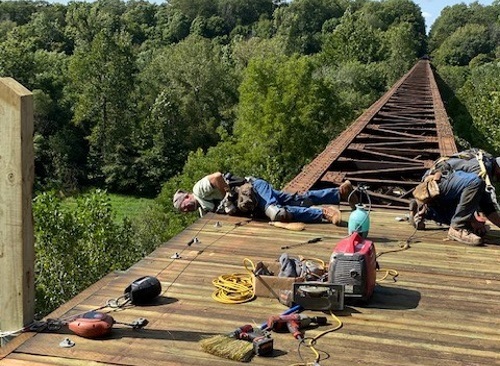The Illinois Department of Transportation recently completed a study that outlines a variety of potential benefits from a proposed extension of the Urbana Kickapoo Rail-to-Trail project.
[Photo courtesy of Illinois Department of Transportation.]
Known as the “KRT,” the agency said in a statement that the proposed trail extension project – which includes improved access for the Carle Health System and University of Illinois campuses – would “increase opportunities for active lifestyle habits, environmental enhancements, and economic benefits.”
The 24.5-mile KRT – formerly the Chessie Seaboard Multiplier/Conrail railroad – links Urbana to Kickapoo State Park passing through St. Joseph, Ogden, Fithian, Muncie, and Oakwood. The Illinois DOT has already helped develop approximately 7.5 miles of this corridor for recreation, including hiking, biking, and other non-motorized purposes, bringing economic, transportation, and environmental benefits to these communities.
The Illinois DOT noted that it has supported work on this trail – which touches some of the most diverse ecosystems in the area, including woodland, prairie, and wetlands – via $5.3 million in funds distributed through Illinois Transportation Enhancement Program grants.
In 2019, the agency’s District 5 Office of Highways Project Implementation joined local agencies for the construction of a 1,300-foot bridge on the KRT. The bridge project – targeted for completion in the spring of 2021 – sports an 88-foot elevation, providing a “spectacular vantage point” over the North Fork Vermilion River.
The Illinois DOT noted that acquiring the land for the KRT took nearly 20 years, with the trail’s development the result of partnerships between the county conservation districts, local communities, and the state. Plans for future advancement include fundraising, land acquisition, engineering, and environmental surveys.
A report issued by the Rails-to-Trails Conservancy in October 2019 analyzed the potential economic benefits of “active transportation” investments, such as conversions of former railroad track areas to walking/biking trails.
The group’s report found that shifting short trips from driving to walking and biking via connected active-transportation infrastructure could help generate a return on investment of $73 billion to $138 billion per year in the United States if connected to public transit systems.
A key factor in its savings calculation argument is building more “synergy” between active transportation and public transportation. Currently, Rails-to-Trails said just 2.5 percent of all trips and 5 percent of work trips are made via public transit systems.

